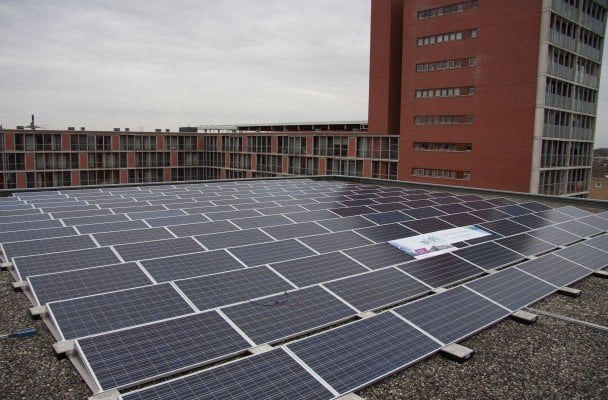
Member states of the European Union have reached agreement on stricter energy standards for buildings. New rules will apply to both new and existing commercial and residential buildings. The target, as set out in the EU’s climate plans, is for all buildings to be energy neutral by 2050.
There are already energy labels for buildings in place now, but they are primarily informative in scope. What is new about the plans of the European Union is that, step by step, all buildings will be required to become more and more sustainable.
The strictest standards will apply to newly built buildings. In the case of existing buildings, a requirement will be imposed that when a building is extensively renovated, its overall energy efficiency rating must be improved.
For newly built buildings, EU member states have agreed that from 2028 onward, all new government buildings must be emission-free. From 2030, that standard will also apply to all new buildings, including residential properties.
Member states stray from the European Commission proposal
As for existing buildings, the rules are more complex. European member states want the 15 percent worst-performing commercial buildings to be renovated by 2030 and subsequently no longer fall into the worst category. By 2034, even 25 percent of the least energy-efficient commercial buildings must be made sustainable.
By advocating these percentages, European member states are straying from the initial idea proposed by the European Commission. The latter had proposed linking the energy standards to the existing energy label system.
In that case, the standard that would apply is that commercial buildings would have to comply with at the very minimum with label F by 2027 and label E by 2030. The use of ‘energy efficiency classes’ would have offered the advantage of working on the basis of definitions that would be more or less consistent throughout the European Union.

National rules
The problem is that the disparities in the building stock among member states are, if anything, even greater than the cultural differences between the different parts of Europe. As a result, working with uniform standards poses considerable difficulties. Partly for this reason, member states would prefer to continue to work on the basis of national rules. That is a setback for those in favor of as much harmonization as possible when it comes to setting climate and energy targets.
In the text that member states have agreed upon, it states that the goal is to “encourage renovation and phase out poorly-performing buildings.” Whether that actually means that any buildings unable to comply with the standard should no longer be in use, however, remains unclear.
A spokesperson for the European Union points out that the new rules must be incorporated into national law by each member state and that it is subsequently up to the member states themselves to meet the targets and enforce the standards.
Housing also falls under new regulations
Rules will be slightly different for existing homes than for commercial properties. Requirements will be linked to the national plans that each member state must draw up to ensure that all existing homes are emission-free by 2050.
Two interim targets have however been set. Namely, in 2033 the average consumption of the entire housing stock of a member state will need to be in compliance with energy label D. A new measurement period will follow in 2040 that must make clear separately for each member state whether the 2050 climate-neutral target is within reach.
It is noteworthy that the member states have changed the rules on which energy sources are permissible for powering an emission-free building. The text now states that it must be ‘carbon-free energy‘. That was reportedly added under pressure from the nuclear energy country of France.

Much work to do in not much time
The new guidelines do not only concern offices and residential buildings. New requirements are also being introduced for parking spaces at businesses, for instance. Offices with more than 20 parking spaces, for one, must see to it within five years that 10% of the parking spaces are equipped to charge electric cars. Furthermore, half of the parking spaces will need to be readied to be easily retrofitted with charging stations at a later date.
In order to stimulate sustainable transport, the position of bicycles must also be improved. For example, 15% of the area surface of an office building parking garage should be set aside for bicycle storage.
For residential buildings, new residential buildings or buildings undergoing renovation will be required to provide space for a minimum of two bicycles per residence. In addition, if such residential complexes have more than three parking spaces, at least half of those spaces must be equipped with a charging station. The remaining parking spaces will need to be prepared for charging stations that can easily be installed in the future.
Solar panels will become mandatory
Last but not least, the package of proposals also includes new rules concerning the installation of solar panels. New buildings must be built in such a way that they are able to make optimal use of solar energy. As of Dec. 31, 2026, each new government building or private office building larger than 250 square meters must then actually be fitted with solar panels.
Two years later, major renovations of existing office buildings larger than 400 square meters will also be required to install solar panels. Then from the end of 2029, solar panels will be mandatory for every new home.
European Parliament set to make the next move
The fact that European member states have reached agreement today does not mean that everything is already settled. The European Parliament will set out its position on the new directive next month. After that, the member states and the Parliament must come to a mutual agreement.
This promises to be a difficult discussion especially where energy standards of buildings are concerned. The expectation is that, unlike the member states, the European Parliament will want to persist with energy certificates. This directive will only be definite once the member states and the European Parliament are able to agree on a compromise. Negotiations will last well into the first half of next year at the very least.

